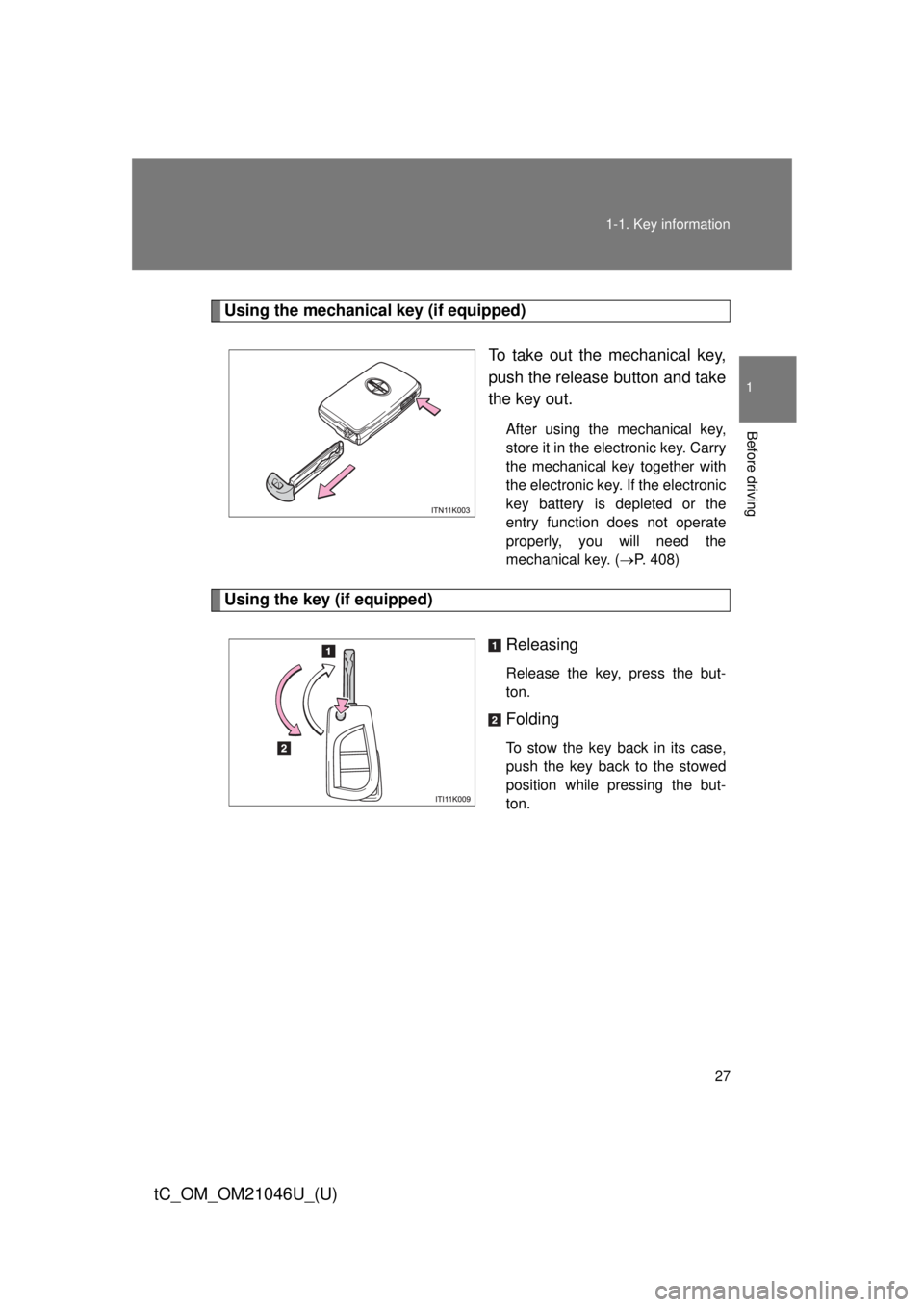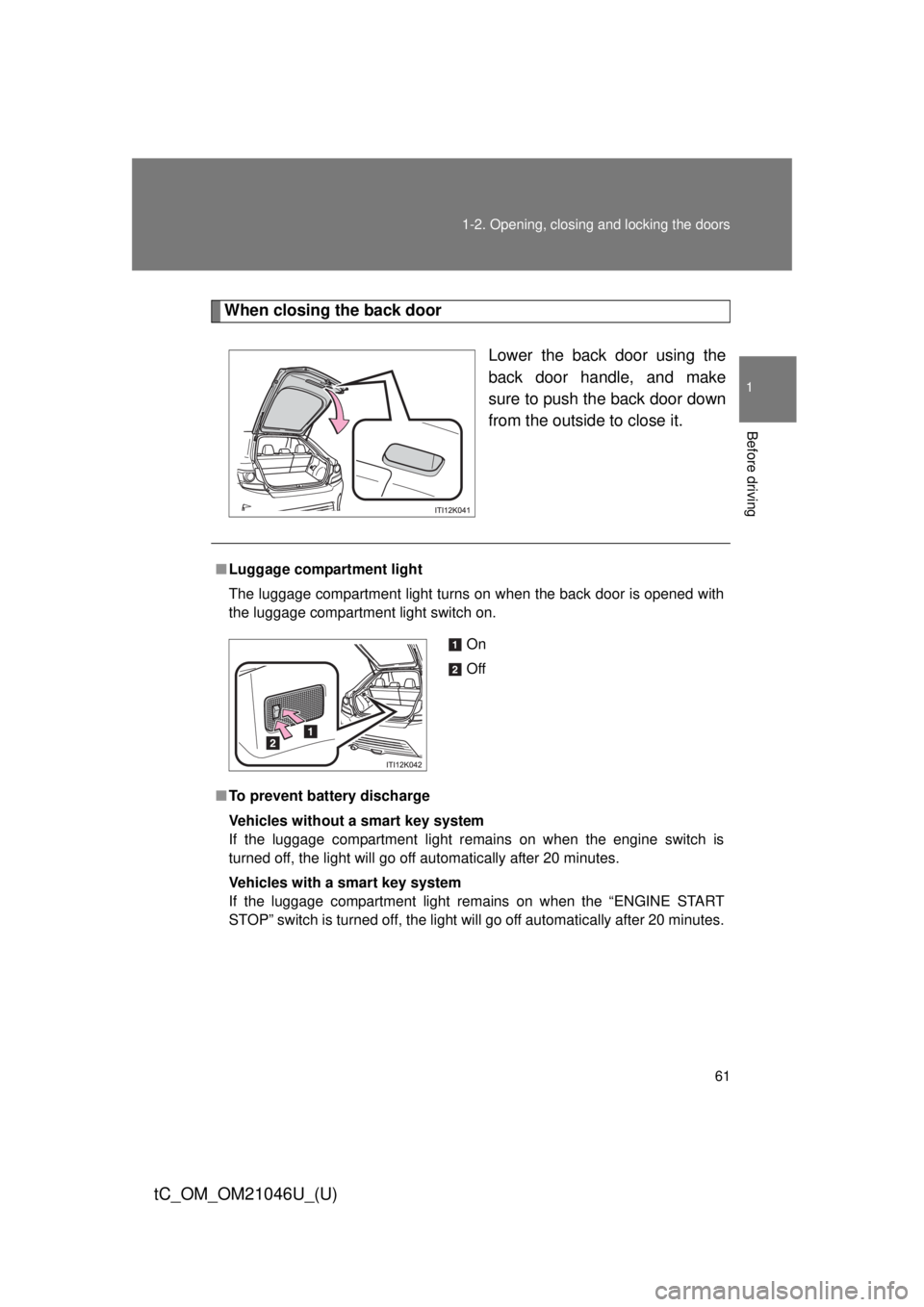key battery TOYOTA tC 2014 Owners Manual (in English)
[x] Cancel search | Manufacturer: TOYOTA, Model Year: 2014, Model line: tC, Model: TOYOTA tC 2014Pages: 488, PDF Size: 9.33 MB
Page 4 of 488

TABLE OF CONTENTSIndex
4
tC_OM_OM21046U_(U)
4-1. Maintenance and careCleaning and protecting the vehicle exterior ........... 272
Cleaning and protecting the vehicle interior ............ 276
4-2. Maintenance Maintenance requirements .................... 279
General maintenance ......... 282
Emission inspection and maintenance (I/M)
programs .......................... 286
4-3. Do-it-yourself maintenance Do-it-yourself service precautions ...................... 287
Hood................................... 292
Positioning a floor jack ....... 294
Engine compartment .......... 296
Tires ................................... 312
Tire inflation pressure......... 323
Wheels ............................... 327
Wireless remote control/electronic key
battery .............................. 330
Checking and replacing fuses ................................ 336
Light bulbs .......................... 347 5-1. Essential information
Emergency flashers ............ 360
If your vehicle needs to be towed ........................... 361
If you think something is wrong ............................ 369
Fuel pump shut off system .............................. 370
5-2. Steps to take in an emergency If a warning light turns on or a warning buzzer
sounds... .......................... 371
If you have a flat tire ........... 389
If the engine will not start .................................. 403
If the shift lever cannot be shifted from P (automatic
transmission) .................... 406
If you lose your keys ........... 407
If the electronic key does not operate properly ......... 408
If the vehicle battery is discharged .................... 412
If your vehicle overheats..... 416
If the vehicle becomes stuck ................................. 419
If your vehicle has to be stopped in an
emergency........................ 421
4Maintenance and care5When trouble arises
Page 27 of 488

27
1-1. Key information
1
Before driving
tC_OM_OM21046U_(U)
Using the mechanical key (if equipped)
To take out the mechanical key,
push the release button and take
the key out.
After using the mechanical key,
store it in the electronic key. Carry
the mechanical key together with
the electronic key. If the electronic
key battery is depleted or the
entry function does not operate
properly, you will need the
mechanical key. (P. 408)
Using the key (if equipped)
Releasing
Release the key, press the but-
ton.
Folding
To stow the key back in its case,
push the key back to the stowed
position while pressing the but-
ton.
Page 38 of 488

38 1-2. Opening, closing and locking the doors
tC_OM_OM21046U_(U)
*: If the engine does not start when the electronic key is inside the vehicle,the electronic key battery may be depleted or there may be difficulties
receiving signals from the key. ( P. 408)
AlarmSituationCorrection procedure
Interior alarm
pings once The electronic key has a
low battery
Replace the electronic
key battery
An attempt was made to
start the engine without the
electronic key being
present, or the electronic
key was not functioning
normally Start the engine with
the electronic key
present
*
Interior alarm
pings once and
exterior alarm
sounds 3 timesThe driver’s door was
closed after the key was
carried outside the vehicle,
and the “ENGINE START
STOP” switch was not
turned off
Turn the “ENGINE
START STOP” switch
off and close the
driver’s door again
An occupant carried the
electronic key outside the
vehicle and closed the
door while the “ENGINE
START STOP” switch was
not off Bring the electronic
key back into the vehi-
cle
Page 40 of 488

40 1-2. Opening, closing and locking the doors
tC_OM_OM21046U_(U)
■Battery-saving function
In the following circumstances, the entry function is disabled in order to pre-
vent the vehicle battery from discharging and the electronic key battery from
depleting.
●When the entry function has not been used for 5 days or more
● When the electronic key has been left within approximately 6 ft. (2 m) of
the vehicle for 10 minutes or more
● If the entry function has not been used for 14 days or more, the vehicle
cannot be unlocked by a door other than the driver’s door. To unlock the
vehicle, grip the driver’s door handle or use the wireless remote control
or the mechanical key.
The system will resume operation when:
● The vehicle is locked using the lock sensor when carrying the electronic
key on your person.
● The vehicle is locked/unlocked using the wireless remote control.
( P. 4 8 )
● The vehicle is locked/unlocked using the mechanical key. ( P. 408)
Page 41 of 488

41
1-2. Opening, closing and locking the doors
1
Before driving
tC_OM_OM21046U_(U)
■
Conditions aff ecting operation
The smart key system uses weak radio waves. In the following situations,
the communication between the electronic key and the vehicle may be
affected, preventing the smart key system, wireless remote control and
immobilizer system from operating properly. (Ways of coping: P. 408)
● When the electronic key battery is depleted
● Near a TV tower, electric power plant, gas station, radio station, large dis-
play, airport or other facility that generates strong radio waves or electri-
cal noise
● When carrying a portable radio, ce llular phone, cordless phone or other
wireless communication devices
● When the electronic key is in contact with, or is covered by the following
metallic objects
• Cards to which aluminum foil is attached
• Cigarette boxes that have aluminum foil inside
• Metallic wallets or bags
• Coins
• Hand warmers made of metal
• Media such as CDs and DVDs
● When multiple electronic keys are in the vicinity
● When another wireless key (that emits radio waves) is being used nearby
● When carrying the electronic key together with the following devices that
emit radio waves
• Another vehicle’s electronic key or a wireless key that emits radio
waves
• Personal computers or personal digital assistants (PDAs)
• Digital audio players
• Portable game systems
● If window tint with a metallic content or metallic objects are attached to
the rear window
Page 45 of 488

45
1-2. Opening, closing and locking the doors
1
Before driving
tC_OM_OM21046U_(U)
■
Electronic key battery depletion
●The standard battery life is 1 to 2 years.
● If the battery becomes low, an alarm will sound in the cabin when the
engine stops. ( P. 36)
● As the electronic key always receives radio waves, the battery will
become depleted even if the electronic key is not used. The following
symptoms indicate that the electronic key battery may be depleted.
Replace the battery when necessary. ( P. 330)
• The smart key system or the wireless remote control does not operate.
• The detection area becomes smaller.
• The LED indicator on the key surface does not turn on.
● To avoid serious deterioration, do not leave the electronic key within 3 ft.
(1 m) of the following electrical appliances that produce a magnetic field.
•TVs
• Personal computers
• Recharging cellular phones or cordless phones
• Cellular phones, cordless phones and battery chargers
• Induction cookers
• Table lamps
■ When the electronic key battery is fully depleted
P. 330
■ Customization that can be configured at Scion dealer
Settings (e.g. smart key system) can be changed.
(Customizable features: P. 453)
Page 50 of 488

50 1-2. Opening, closing and locking the doors
tC_OM_OM21046U_(U)
■Security feature
If a door is not opened within approximately 60 seconds after the vehicle is
unlocked, the security feature automatically locks the vehicle again.
■ Conditions affecting operation
The wireless remote control function may not operate normally in the follow-
ing situations:
Vehicles without a smart key system
●Near a TV tower, radio station, electr ic power plant, airport or other facil-
ity that generates strong radio waves
● When carrying a portable radio, cell ular phone or other wireless commu-
nication devices
● When multiple wireless keys are in the vicinity
● When the wireless key is in contact with, or is covered by, a metallic
object
● When a wireless key (that emits radio waves) is being used nearby
● When the wireless key has been left near an electrical appliance such as
a personal computer
Vehicles with a smart key system
P. 4 1
■ If the wireless remote control does not operate properly (vehicles with
a smart key system)
Locking and unlocking the doors: Use the mechanical key. ( P. 408)
■ Key battery depletion
Vehicles without a smart key system
If the wireless remote control function does not operate, the battery may be
depleted. Replace the battery when necessary. ( P. 330)
Vehicles with a smart key system
P. 4 5
Page 51 of 488

51
1-2. Opening, closing and locking the doors
1
Before driving
tC_OM_OM21046U_(U)
■
When the electronic key battery is fully depleted
P. 330
■ Customization that can be configured at Scion dealer
Settings (e.g. wireless remote control system) can be changed.
(Customizable features: P. 453)
■ Certification for wireless remote co ntrol (vehicles without a smart key
system)
U.S.A.
FCC ID: MOZB41RH
FCC ID: MOZB52TH
FCC ID: MOZB95TH
NOTE:
This device complies with part 15 of the FCC Rules. Operation is subject to
the following two conditions: (1) This device may not cause harmful interfer-
ence, and (2) this device must accept any interference received, including
interference that may cause undesired operation.
FCC WARNING:
Changes or modifications not expressly approved by the party responsible
for compliance could void the user’s authority to operate the equipment.
The FCC ID/IC Certification number is affixed inside the equipment. You can
find the ID/number when replacing the battery.
Canada
NOTE:
This device complies with Industry Canada licence-exempt RSS stan-
dard(s). Operation is subject to the following two conditions: (1) this device
may not cause interference, and (2) this device must accept any interfer-
ence, including interference that may cause undesired operation of the
device.
The FCC ID/IC Certification number is affixed inside the equipment. You can
find the ID/number when replacing the battery.
Page 61 of 488

61
1-2. Opening, closing and locking the doors
1
Before driving
tC_OM_OM21046U_(U)
When closing the back door
Lower the back door using the
back door handle, and make
sure to push the back door down
from the outside to close it.
■Luggage compartment light
The luggage compartment light turns on when the back door is opened with
the luggage compartment light switch on.
■ To prevent battery discharge
Vehicles without a smart key system
If the luggage compartment light remains on when the engine switch is
turned off, the light will go off automatically after 20 minutes.
Vehicles with a smart key system
If the luggage compartment light remains on when the “ENGINE START
STOP” switch is turned off, the light will go off automatically after 20 minutes.
On
Off
Page 174 of 488

174 2-1. Driving procedures
tC_OM_OM21046U_(U)
■Auto power off function
Vehicles with an automatic transmission
If the vehicle is left in ACCESSORY mode for more than 20 minutes or IGNI-
TION ON mode (the engine is not running) for more than an hour with the
shift lever in P, the “ENGINE START STOP” switch will automatically turn off.
However, this function cannot entirely prevent battery discharge. Do not
leave the vehicle with the “ENGINE START STOP” switch in ACCESSORY
or IGNITION ON mode for long periods of time when the engine is not run-
ning.
Vehicles with a manual transmission
If the vehicle is left in ACCESSORY mode for more than 20 minutes or IGNI-
TION ON mode (the engine is not running) for more than an hour, the
“ENGINE START STOP” switch will automatically turn off. However, this
function cannot entirely prevent battery discharge. Do not leave the vehicle
with the “ENGINE START STOP” switch in ACCESSORY or IGNITION ON
mode for long periods of time when the engine is not running.
■ Operation of the “ENGINE START STOP” switch
When operating the “ENGINE START STOP” switch, one short, firm press is
enough. If the switch is pressed improperly, the engine may not start or the
“ENGINE START STOP” switch mode may not change. It is not necessary to
press and hold the switch.
■ Electronic key battery depletion
P. 4 5
■ Conditions affecting operation
P. 4 1
■ Note for the entry function
P. 4 2